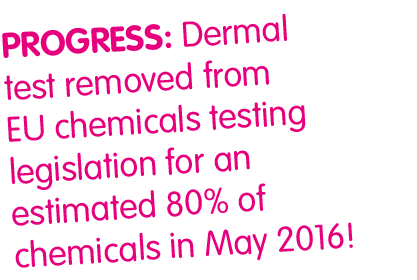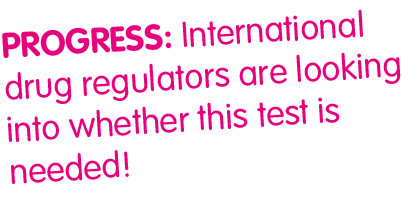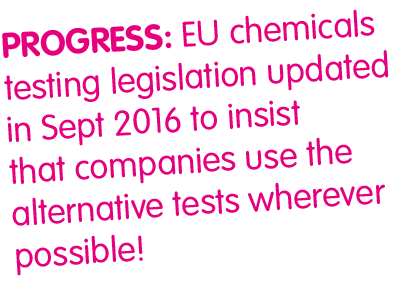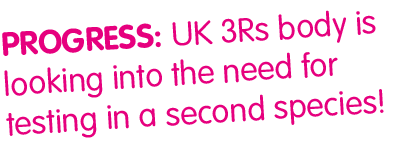Replace Animal Tests: the RAT list
10 animal tests that should be replaced
 We have created the RAT (Replace Animal Tests) list to highlight ten of the worst animal tests, which in our view are either redundant or have valid replacements.
We have created the RAT (Replace Animal Tests) list to highlight ten of the worst animal tests, which in our view are either redundant or have valid replacements.
If we can remove these ten tests it could save half a million animals’ lives every year in Europe alone.
Find out how you can help us save half a million animals.
|
Test and number of animals used annually |
Description of Test |
Options for replacement |
|---|---|---|
|
Pyrogen test – Rabbits 3,167 pyrogen tests were done in the UK alone in 2014. Across the EU the number is thought to be around 200,000. |
Rabbits are restrained in boxes for up to eight hours per test, with food and water restriction prior to this. Rabbits can suffer a fever reaction (in the rare occasion the batch is contaminated), and damage to ears from repeated injections. Temperature probes are inserted deep into their rectums during the test. Rabbits may be housed singly during their lives and are typically re-used several times. |
This test has been replaced by a test which uses blood from horseshoe crabs, and more recently with an even better test based on human cryo-preserved blood. |
|
Botulinum toxin test – Mice 220,544 mice were used in LD50 tests in Europe in 2011 alone. We have strong reason to believe that a large proportion of these tests were botulinum toxin (botox) tests. |
This is an LD50 (Lethal Dose 50%) test aimed at determining the dose that kills exactly half of the animals used. The mice are injected into their abdomens with the botulinum toxin and over the next three days become increasingly paralysed. If left, mice in the higher dose groups will suffocate to death within approximately three days. Approximately 50% of the mice per test die. The rest are killed at the end of the test anyway. |
Some toxin manufacturers have now developed a cell-based test to replace the batch test, but they continue to use the mouse test for some purposes. Regulators are not enforcing the use of these cell-based tests for all other manufacturers. |
|
Acute toxicity test – Rats 4,431 rats were used across Europe in 2011.
|
Animals are exposed to very high doses, which can cause severe illness (difficulty breathing, weight loss, convulsions, bleeding) and death. Death is used as the ‘endpoint’ in tests via the dermal or inhalation route. In tests where the animals are force-fed, the researchers may kill the animal before they die but only if they are extremely ill and they are found before they die. |
This test is redundant in many cases as companies use another animal test (the repeated dose test) for their safety purposes. This was demonstrated for pharmaceuticals in 2008. A humane simple cell-based test was validated in 2013 and now can be used to demonstrate absence of toxicity but is not yet in common use. |
|
Ecotoxicity – Fish 71,406 fish were used in acute and chronic toxicity tests in Europe in 2011. |
Young fish are exposed to the test substance dissolved in their tanks for 96 hours. The acute test is a lethal test - 50% of the fish are expected to die. Fish tend to be found dead and are not humanely killed. Chronic tests can also cause death. |
The Zebrafish Embryo Acute Toxicity Test Method (ZFET) and the Short-term Toxicity Test on Embryo and Sac-Fry Stages are replacements of the acute and chronic fish toxicity tests respectively, and use fish embryos rather than young fish. The ZFET has been shown to agree with adult acute fish test results 90% of the time. |
|
Carcinogenicity – Rats and mice 11,826 rats and mice were used in carcinogenicity tests across Europe in 2011.
|
Mice or rats are given a substance either in their diet, drinking water or are force-fed every day for two years. All of the animals are then killed and dissected to see if the substance leads to signs of cancer. Animals often suffer from spontaneous cancers during the experiment that may not be due to the substance. |
Because of its unreliability and expense, this test is losing popularity and is rarely required for chemicals and cosmetics. However, it is still a requirement in the legislation and guidance. |
|
Eye Irritation – Rabbits 2,080 rabbits were used in eye irritation tests across Europe in 2011.
|
The substance is left in one rabbit’s eye for at least one hour before it may be washed out. The eyes are then examined for signs of irritation and damage over 3 days. If there are no signs of severe irritation in the initial test, two more rabbits are used. Rabbits are forced to suffer restraint whilst being dosed and examined and can experience painful damage in their eyes that can lead to blindness. |
Eyes from dead hens and cows can be used in validated tests to identify severe irritants and non-irritants. Reconstituted human eye models have also now been accepted. |
|
Skin irritation – Rabbits 3,151 rabbits were used in skin irritation tests across Europe in 2011.
|
The product is rubbed onto a 6cm area of a rabbit’s shaved skin on their backs and held in place with a bandage for four hours. The rabbit is then examined for signs of skin damage for 14 days. If there are no signs of irritation in the initial test, two more rabbits are used in a ‘confirmatory test’. Rabbits are singly housed and can suffer from painful skin reactions and rashes. |
The test can now be completely replaced with reconstituted human skin models, which are validated and widely accepted. They are more predictive than the rabbit test. |
|
Skin sensitisation (allergy) – Guinea pigs and mice 15,214 guinea pigs were used in guinea pig maximisation test (GPMT) and 16,846 mice were used in LLNA (Local Lymph Node Assay) skin sensitization tests in Europe in 2011.
|
In the GPMT guinea pigs are injected six times in their backs with a substance that increases their body’s immune response to the test chemical. Six days later the test chemical is rubbed onto their shaved skin. On day 20 the chemical is applied again. The animal is observed daily for allergic reactions until the end of the 23-day test. The guinea pigs may be killed and dissected to confirm any unusual reactions. They may be singly housed and suffer from painful skin reactions and rashes. In the LLNA the test substance is painted onto the ears of mice every day for three days. The mice are then killed three days later and their ears are dissected. |
The GPMT was replaced by the LLNA in 1999; but the LLNA itself is now replaced. Chemical based (DPRA) and cell based tests (ARE-Nrf2 -KeratinoSens) have been formally accepted by the OECD in 2015. Currently, at least two alternative tests need to replace the LLNA, however this strategy has been shown to consistently predict 90% of human skin reactions. |
|
Second species repeated dose toxicity test – Dogs and monkeys 2,785 dogs were used in repeated dose tests along with 1,306 monkeys in Europe 2011.
|
Dogs or monkeys are used as a second species after mice or rats to test the safety of human medicines. Animals are dosed every day for between two weeks to nine months with drugs that might lead to harmful side effects that can include vomiting, diarrhoea, internal bleeding and organ damage, seizures, paralysis and even death. They are also subjected to other stressful tests such as repeat blood sampling and daily gavage. Monkeys are usually imported from Africa or SE Asia for these tests and may have been born to parents or grandparents that were taken from the wild. |
Research conducted by Cruelty Free International has recently provided more evidence that this test does not help show whether a drug is likely to be toxic to humans. Cell based tests and computer models are in use but are not considered adequate by regulators or the industry. |
|
Second species prenatal developmental toxicity tests – Rabbits and monkeys 2,560 rabbits and 281 monkeys were used in developmental toxicity tests in Europe in 2011. |
Rabbits or monkeys may be used in an additional ‘second species’ test after similar tests in rats. The animals are force-fed the test chemical during most of their pregnancy and are killed the day before they are due to give birth. Their pups are extracted by caesarean section and examined before being killed. Due to the high doses used, the chemicals may cause the mother to become ill and some chemicals could lead to deformities, stillbirths or miscarriages. |
There is little evidence that testing on a second species adds to the safety of chemicals. Several studies have indicated that the test in rabbits may be unnecessary and should not be conducted, but regulators are inconsistent in their rules. |









